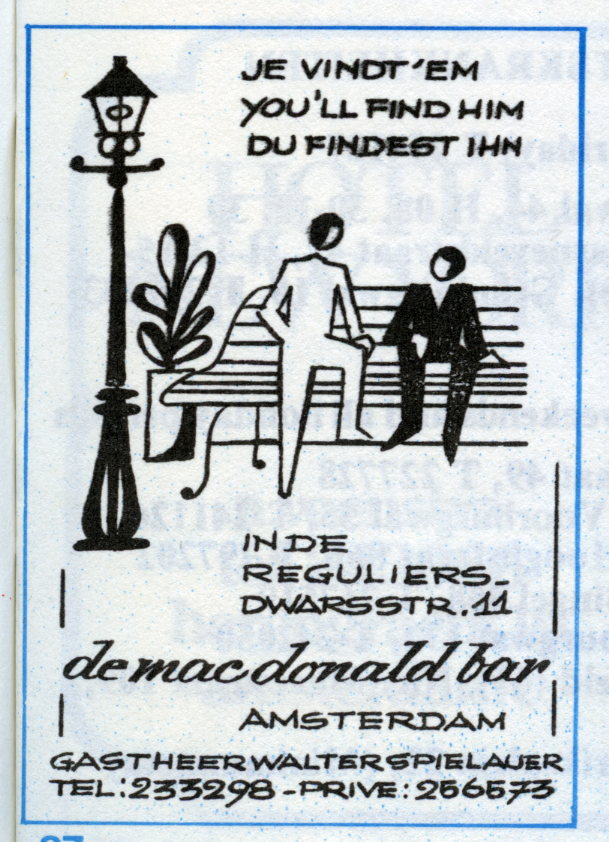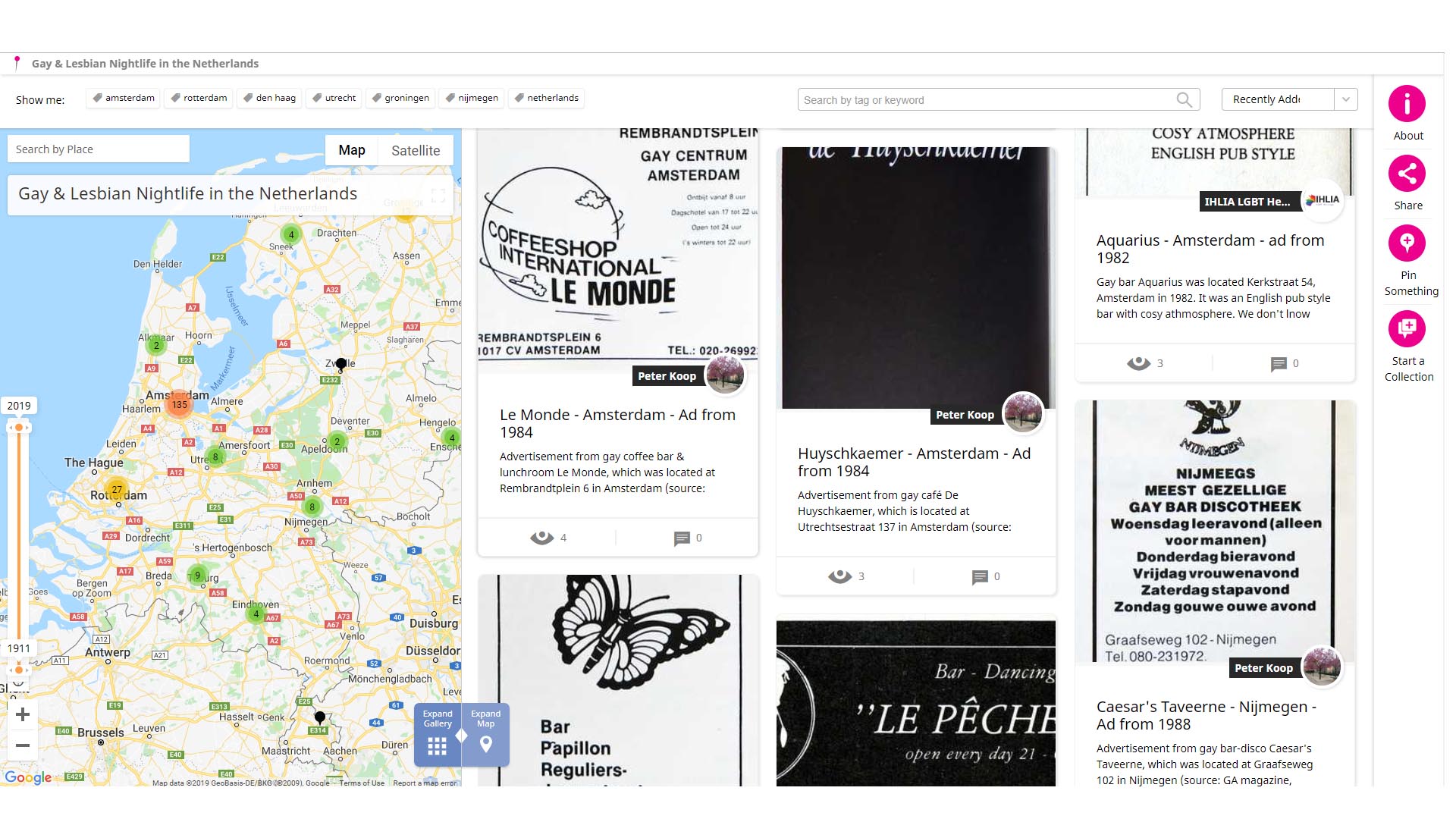From today to consult: an overview of the Dutch gay / lesbian nightlife over the years on the platform for social history: Historypin.
IHLIA launches this unique Gay & Lesbian Nightlife database on Historypin today, in collaboration with hospitality specialist Peter Koop from Reguliers.net. We spoke with Connie van Gils, employee of IHLIA and the trigger of this project.
First of all, why a database of the history of gay nightlife in the Netherlands?
“It is a glorious history. The history of gay / lesbian hospitality in the Netherlands started in the twenties of the last century. That was the time that the vice police could invade every moment in search of minors. This small-scale gay venues expanded, which applied, to a lesser extent, to the lesbian bars. It experienced its heyday in the eighties. From all over Europe and even far beyond, mainly gay men came to Amsterdam to go out. In the nineties it became less, even though the most spectacular clubs such as the RoXY, Mazzo and the iT were to be found at the time. The trend towards less special interest bars has continued. There are still special gay bars and cruising bars, but there is a tendency to open to all. LGBTs and straight men together.”
How far are you with that database of pubs?
“At the moment we have a small 200 pubs in the database. That is quite a lot, but I still think we are not halfway. We do not have footage available on all venues, and we do need that to be able to continue.”
What can you do with the database?
“You can see where, when, which pub was. You can zoom in and zoom out on the map of the Netherlands, the big cities you can choose at once via a tag.
With a special time bar you can shift the time and there is a search function, very useful to enter the name of a bar, street or smaller city.
By default you see the last added bars. But you can also sort on A-Z or most popular (in terms of online visitors to gay & lesbian nightlife, spoiler: the Web). Finally, you can choose oldest pub or newest pub in time. Perhaps the most interesting option.”
What kind of visual material do you use to describe history?
“At IHLIA we have a wonderful collection of merchandise and memorabilia, including many vintage realies from pubs. You can think of matchboxes, beer mats, stickers, lighters, buttons, glasses, entrance tickets and T-shirts from bars. After we had digitized it and saw how the visual language used gives a nice picture of the times, I started putting the collection of catering-related pictures on Historypin. That was the start of the project Gay & Lesbian Nightlife in the Netherlands. Meanwhile, we also use a lot of pictures of flyers and advertisements, but ‘things’ we like the most. ”
Who do you hope to achieve?
With this overview we hope to be of service to students, journalists and other interested parties. The database can serve as a basis for research into the lhbt history of a particular city, street or building, or of a particular bar or bar. At bar you can think of travesty bars, leather bars, lesbian bars or cruising bars with darkrooms.
You can investigate the effect of the AIDS crisis on nightlife, gay marriage or the effect of social media and dating apps in the Netherlands.
You can investigate how language and image have been dealt with in the past century. Special ‘flikker en potten’ evenings are now no longer mentioned. There is also a development in announcements such as travesty, girlfriends, drag and trans, because where does it start and where does the other end?”
Facilitate research and encourage research?
“Well, do not forget the pub visitors. Many people have warm memories of their favorite bar, at the bars where they could be themselves for the first time, were able to magnify themselves, even where they met their first loved one, lost their hearts, got drunk, found sexual partners, or where they made fun with friends and girlfriends. This database is also interesting for them.”
Why did you choose Historypin as a platform and not Facebook, Instagram, Flickr or Pinterest?
“Historypin is more than just a nice picture. It is unique in how it can reflect social history, because you can link a picture to both the physical location and the period. Take, for example, a legendary bar like the MacDonald in the Reguliersdwarsstraat, Amsterdam. At Gay & Lesbian Nightlife you can immediately see on the map where it was and from when to when and there is a link that leads to more information about that pub. There is no such thing yet, so it is a world first that hopefully will be followed.”
You start right away about Amsterdam. Is the database focused on Amsterdam?
“Because we are based in Amsterdam and Amsterdam has a rich history of gay venues, Peter Koop and I have achieved the most results with the history of Amsterdam so far. Low hanging fruit. However, we also want to describe the other big cities, because there was a time when every hamlet had a gay pub. We want to show that too.”
So work in progress?
“You can say that, yes. We do have the ambition, but not the illusion that it will ever be finished. We should actually have a few other experts who want to help.”
What else?
“Do you have additional information for us, do you see any mistakes, or do you have any merchandise that we may use? Please contact Connie van Gils: connie@ihlia.nl or Peter Koop: info@reguliers.net.
We are happy with every addition! If you come anywhere, take a little something for us, a bingo card, entrance ticket or a plastic glass with the name of the bar! (a photo of it is also good!).”
How do we find the database?
https://www.historypin.org/en/gay-lesbian-nightlife-amsterdam/geo/52.132633,5.291266,8/bounds/50.639869,3.621473,53.577004,6.961059/paging/1


